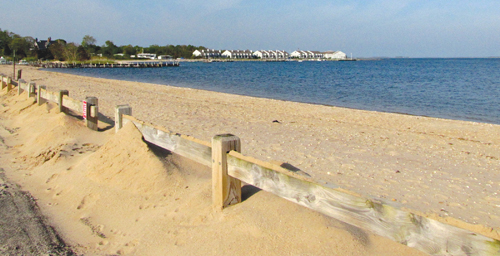State adds sea level rise as reason to justify CPF purchases

Gov. Andrew Cuomo enacted a law last week aimed at protecting and preserving East End coastlines that are at significant risk to climate change and sea level rise.
Proposed by Assemblyman Fred Thiele (I-Sag Harbor), the new law notes rising sea levels as one reason towns can purchase shorefront property using Community Preservation Fund dollars.
While towns could previously purchase undeveloped land on the shore, climate change could not specifically be one reason why towns were paying for them.
“What we wanted to do was to put in the statute that one of the factors towns can consider is the issue of climae change, and sea level rise,” said Thiele. “While there may be disagreement as to their cause, nobody can deny that [climate change] is happening.”
The law, signed last Wednesday, came just days before the one-year anniversary of Hurricane Sandy, which damaged shorelines along the North Fork.
Each of the five towns uses a Community Preservation Fund to preserve environmentally sensitive land for open space, farmland preservation, historic preservation and parks for recreational use, but existing law did not specifically include at-risk coastlines, he said.
The fund, approved by referendum of East End voters in 1998, applies a 2 percent tax on all real estate transfers to set aside funds for land preservation purchases.
According to Mr. Thiele, real estate transfer tax revenues for the first nine months of 2013 have raised $1.77 million for Riverhead Town, while Southold Town has taken in $2.98 million. Since the fund’s start, more than 10,000 acres of land have been preserved.
“In the wake of Superstorm Sandy, it was recognized that there was also a need to further ensure that we also protect lands that are at risk of coastal flooding and sea level rise,” Mr. Thiele said. “These sensitive lands are critical to the future of our local coastal communities.”
According to the U.S. Environmental Protection Agency, increases in heavier rainfall and projected sea level rise could lead to more frequent damaging floods – along with storm surges of greater intensity in the Northeast.
“It is fitting that we take this step to conserve our beautiful and pristine beaches that not only act as a buffer to protect our coastal communities but also represent an emblematic symbol of Long Island’s East End,” said Senator Ken LaValle (R-Port Jefferson), who sponsored the state Senate bill.
Southold Supervisor Scott Russell said the town has been examining areas that may meet the new law’s criteria.
“If it’s undeveloped shoreline – our interests are already there,” Mr. Russell said. The town had been looking into acquiring funding thorough the USDA Natural Resource Conservation Service to purchase coastal farmland at a high risk of flooding. The new law gives the town another option to work with, he said.
“The land preservation committee will look at the new law and see how we can make it work for Southold,” he said.
Riverhead Supervisor Sean Walter said the town has “attempted to buy wetlands in coastal areas since the inception of the fund, but now this gives us the absolute authority where as before it was more of a general authority as open space.
“It’s a good thing, unfortunately for the Town of Riverhead; we don’t have much CPF money left – but it’s a good tool to have for the future,” he said.
In the early 2000s, Riverhead Town leaders started borrowing against future CPF revenues to buy open land before an anticipated rise in real estate values. But when real estate market stalled, revenues to pay off the debt did not come in as expected, leaving an annual shortfall of nearly $4 million, according to a News-Review report.
Should the town find the appropriate funds, Mr. Walter said the coastal area off Creek Road in Wading River is an example of a space the town might be interested in.
“The houses along Creek Road are always at risk because it is a bit of barrier road that protects the wetlands,” Mr. Walter said.
Long Island Pine Barrens Society executive director Richard Amper said “the key word in this legislation is ‘undeveloped’ lands.”
“This is what the original act intended, so this particular bill makes clear that vulnerable coastal areas will be a priority for CPF finding in the years ahead,” Mr. Amper said. “Sea level rise will affect Long Island Sound and it will affect the Peconic bays.”
Suffolk County Legislator Al Krupski (D-Cutchogue) said towns could gain waterfront access while protecting sensitive marshland that needs to be preserved – actions that many towns are already invested in.
“It’s not really a departure from what we’re doing now,” said Mr. Krupski. “The areas you’re talking about, they are areas already important to the program.”
Adding coastline into the mix with already sought-after farmland and open space means “each town really has to do their due diligence and prioritize,” Mr. Krupski said. “How do they want to spend their money?”








